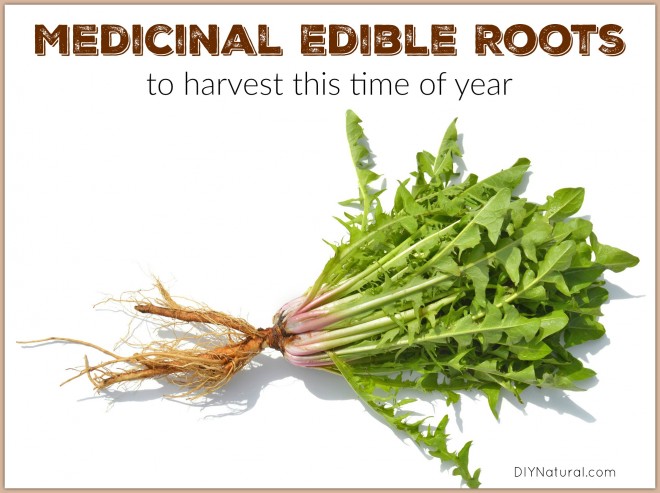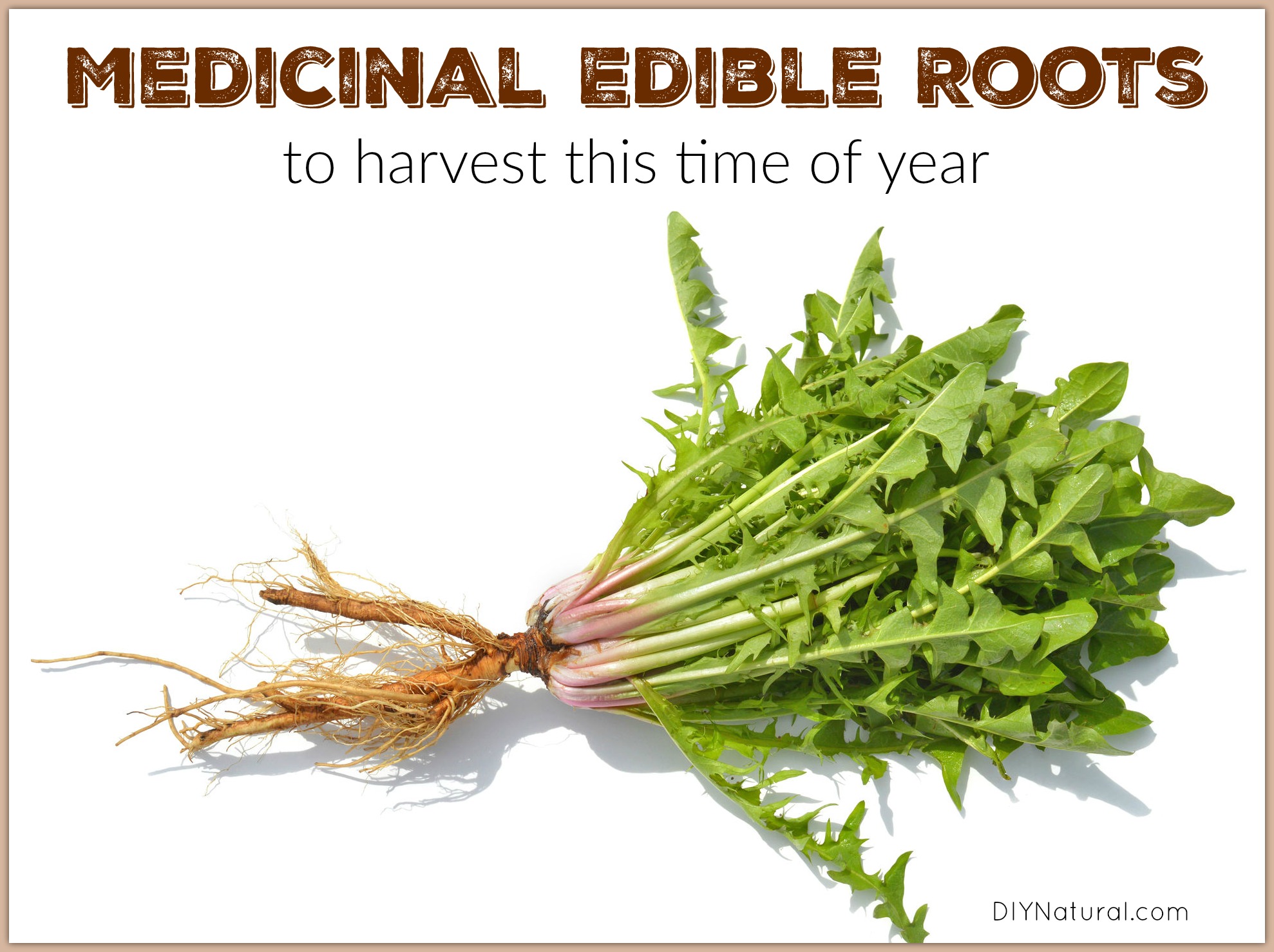
The harsh frosts have come and gone here in Ohio. All of my once beautiful plants are now brown and crispy. You may think this is the end of the road for fresh medicinals in your garden, but luckily that’s not true. While the leaves and flowers have gone by the wayside, now is the time to focus on our medicinal and edible roots.
During the growing season all of the energy in the plant is focused on its above-ground activities. While we may harvest a root here or there for food or medicine during this time, they won’t be at their best. When the plant is focused above ground this often makes the root less dense and less strong. Horseradish, for instance, will not be as strong tasting and can often be woody during the summer, but crisp and pungent in the late fall and winter.
All of the perennial and biannual plants have died back down to their edible roots and now is the time to go get them. Some of the best edible roots tend to leave a bit of green or a tell tale dried stalk standing over the spot where they are hiding. Learn how to identify your favorite plants at this time of year and you’ll have food and medicine all winter long.
5 Edible Roots to Harvest Now
Dandelion (Taraxacum officinale)
Dandelion tends to stay ever-green. You’ll find a rosette of dandelion leaves in your yard even in the dead of winter. When the ground is not frozen, dig a hole straight down beside the root. Grab the top of the plant and pull it sideways into the hole. You may need to pull it back and forth before you are able to pull it straight up out of the hole (this depends on how compact your soil is). Dandelion roots can be sliced and sautéed along with a dinner stir fry, added to soups and broths, or even grated and added to your hashbrowns! While they are delicious, they’ll also be supporting kidney and liver health and providing a healthy dose of potassium, manganese, iron, calcium, vitamins C and B, and betacarotene.
Nettle (Urtica dioica)
If you’re still trying to get used to the idea of using nettle leaf, here’s another surprise. Nettle root is incredibly beneficial for the prostate gland. If you’re digging up an unwanted patch of nettles anyway, you might as well tincture the root and have a supply around to keep the man in your life healthy.
Dont have access to nettle plants? Find organic dried nettle root here.
Yellow Dock (Rumex crispus)
A tincture of yellow dock may just be your best friend if you suffer from severe acne or any other problematic skin disorder. This weed is easy to find once you learn to recognize the characteristic brown seedheads. Yellow dock is in the buckwheat family, so if you’ve ever stuffed a pillow with buckwheat from the craft store you’ll quickly see the family resemblance. Yellow dock root doesn’t taste especially nice, but it provides a power pack of iron and Vitamin C. This root can be tinctured or made into capsules once you’ve dried your stash.
If you don’t have yellow dock growing near you, you can find dried yellow dock root here.
Mullein (Verbascum thapsus)
There is a lot said about the flowers and leaves of mullein, but less mentioned about its root. You’ll find mullein in fields and along roadsides. It has a tall brown candelabra that you can’t miss. Dig the roots and use them in a tincture for swollen prostate, back pain, or bell’s palsy.
Horseradish (Amoracia rusticana)
I’ll be digging some of these edible roots this afternoon. My husband has a sinus congestion that is getting out of hand. A small pinch of horseradish to chew 3-4 times a day ought to help clear things up for him. Horseradish is one of the medicines I most like to eat. It’s best made fresh (grind it outside, trust me!) and used as a sauce or sandwich spread.
*******




I can vouch for the horseradish root. I had the most awful flu and bronchitis this past winter. Just at the start of my holidays too 🙁 Even my normal lifesaver of Echinacea Premium was letting me down this year. I did not want to take antibiotics from the doctor, as I have IBD and medications always upset me and trigger a flare. In desperation I consulted Dr Google and found an obscure blog somewhere raving about horseradish root for bronchitis. I had never seen horseradish root in the shops, I had only ever seen commercial jars of horseradish sauce. Then miracle, the first organic grocer I went to (had for the first time ever), real organically grown roots. So I brought a handful. Added one raw root to the juice I was making that night and oh-my-goodness it nearly blew my little cotton socks off! 🙂 It was very strong. Strong enough to put hairs on my chest I reckon! But it tasted good. Over the course of the weekend I consumed all of the roots in different homemade fruit or vegetable juices and deeply coughed up loads of phlegm, mucus and gunk. And two days later by the Monday night my bronchitis had completely gone. Honestly 100% completely cleared up. Decided to keep juicing the horseradish root as a preventative over the winter but the grocer said he was no longer selling it as no-one (apart from me) had purchased it. Pretty amazing he sold the roots just when I needed them. After further research, I read in Bartram’s Encyclopedia of Herbal Medicine that horseradish is a natural antibiotic. But sadly now I cannot source the fresh root anywhere. The grocer said it is considered an old fashioned herb and hardly anyone wants it nowadays. Tried growing my own but failed 🙁
Forgot to add that the horseradish roots are small and they also yield very little juice…..but honestly you do NOT need much due to their potent strength 🙂 May have been very potent for me; as they were organically grown too. I have a slow-speed cold press non-centrifugal juicer. The juices were mainly a mix of: carrot, grapefruit, orange, lemon and ginger OR kale, broccoli, lemon, apple and ginger. I did not eat any solid heavy food over the weekend either, as did not want to put extra demands on my body with digestion. I just juiced, drank filtered water, had one cup of chicken bone broth, had some pureed carrot soup and drank plain dandelion root tea. But mainly just juiced. The key was the horseradish root. I suppose you could grate it and cook it. But probably better to consume it raw to make it more potent for healing. Would be very had to chew on a root I reckon – best to juice it.
My family has been in the business of harvesting and selling medical roots and herbs for 3 generations now and I would like to know if there is any way that we could work out a market between us. We sell everything dried and unprocessed so there is room for the middle man please get back to me as soon as possible and if interested please include a list along with prices per lb. Thank you for your time.
Sincerely,
Allen Morehead [email protected]